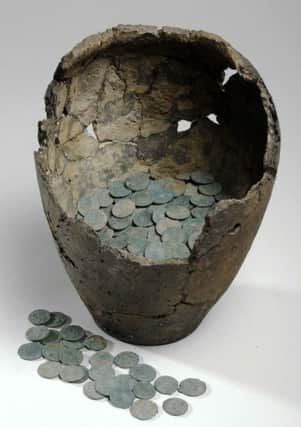Leeds nostalgia: Hoard of Roman coins may have been owner's life savings...


Unearthed after more than 1,600 years, this incredible collection of Roman coins may have been safely stashed underground for safe keeping.
Part of the famous Cridling Stubbs hoard, the remarkable stockpile of more than 3,300 copper coins can be seen in Leeds City Museum’s Ancient Worlds gallery.
Advertisement
Hide AdAdvertisement
Hide AdMost of the coins are dated between AD 300-346 and include special issues in honour of Rome and Constantinople (now Istanbul), and for Constantine the Great and the Caesars, emperors of Rome.
The collection also contains coins struck in memory of Helena, Mother of Constantine the Great, and Theodora, his step-mother.
Found in a field near Cridling Stubbs in the Womersley parish of North Yorkshire 1967, the coins were buried inside a pot with part of a grey-ware jar on top of it as a makeshift lid.
The tenant farmer agreed to sell the container and 447 of the coins to Leeds Museums and Galleries for £300, which were purchased with the aid of a grant from The Art Fund.
Advertisement
Hide AdAdvertisement
Hide AdIt’s believed unique stockpile of more than 3,300 copper coins may have been hidden by the owner inside a large jar in around AD 346 to keep it safe from Saxon and Irish raiders.
Kat Baxter, Leeds Museums and Galleries’ curator of archaeology, said: “It’s possible that these coins were somebody’s savings and were buried to keep them safe underground so they could be dug up at a later date.
“We may never know for sure why they were buried, but the hoard is a truly remarkable and historically significant find which can teach us a lot about life, coins and currency during a turbulent chapter in the story of Roman Britain.”
Leeds City Museum is free to enter and can be found on Millennium Square.
For more details, visit: https://www.leeds.gov.uk/museumsandgalleries/Pages/Leeds-City-Museum.aspx